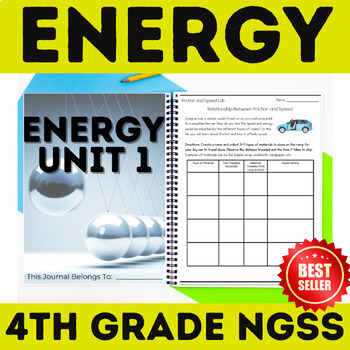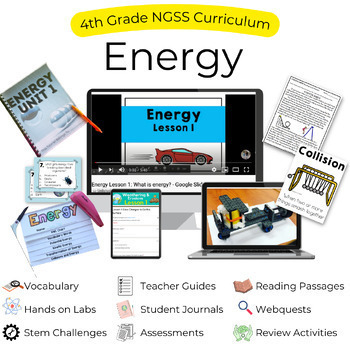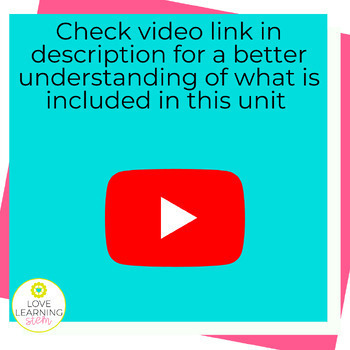4th Grade Energy Unit -Kinetic and Potential Digital Printable Curriculum NGSS
- Zip
- Google Apps™
- Easel Activity

What educators are saying
Products in this Bundle (19)
showing 1-5 of 19 products
Bonus
Description
Are you looking for an engaging 4th Grade Energy Unit aligned to the NGSS Kinetic and Potential Energy standards? This unit is an easy PRINT-AND-GO download. In the PDF you will have the teacher guide as well as the student journals. The lessons are clearly explained, and your students will love learning about kinetic, potential, and collision energy with the hands-on, engaging activities.
What's included in this Energy Unit for Grade 4?
- Easy, Print-and-Go PDF that includes a TEACHER GUIDE and STUDENT JOURNAL (Bonus File).
What can you find in the teacher guide?
- Hyperlinked Table of Contents
- Scope and Sequence
- Video Lectures for Every Lesson (Youtube)
- Lesson Slide Decks (Google Slides and Editable)
- Lesson Check for Understanding (Google Form)
- Lesson plans
- Quick Digital Links to all Assessments
- Materials List
- Tips for Teaching
- Examples of Student Outcomes
- Posters and Vocabulary Journal
- Task Cards
- Flipbooks
- Answer Key
What's in the student journal?
- All the pages the students will need to complete the unit
- Lesson Notes Pages
- Reading Passages and Comprehension
- Engaging Lesson Activities (Webquests, Centers, Stem Challenge)
- Vocabulary Pages
- End of Unit Assessment
- Early Finisher Work (Word Searches, Coloring Pages, Extension Writing Activities, Create-a-Comic, Information Flags)
What are students learning?
This unit is broken down into 5 parts. Each part includes a lesson plan of activities and can take 1-2 weeks to complete. The following is the breakdown of the unit:
- Part 1 - Energy Basics Lessons: Students will complete a 'buy-in' activity by doing a demonstration of what happens to people in cars when they don't wear seat belts. They will read a seatbelt article. Once they get an introduction, they will be guided through the Guided Lesson Slide Deck and complete a learning experience Webquest.
- Part 2 - Potential and Kinetic Energy Lessons: Students will continue learning more about kinetic and potential energy with a Guided Lesson Slide Deck and review the content by completing a flip book and potential and kinetic reading passages. You may display the flip book on bulletin boards.
- Part 3 - Speed and Energy Lessons: Students move on to learn about energy transfer by going through the Guided Lesson Slide Deck and completing reading passages. They will partake in a hands-on science lab (pendulum lab). They may play review games with the task cards or complete them in centers/for homework.
- Part 4 - Energy Transfer Lessons: The students will go through the Guided Lesson Slide Deck and learn about friction, speed, and energy. They will complete a hands-on science lab (friction and energy lab), and complete early finisher work. You may choose to have the students complete assessments after this part or after Part 5.
- Part 5 - Stem Design Challenge Lessons: Students will take everything they have learned about energy in this cumulative project. This project is an Egg Collision STEM Challenge. Students will go through the engineering design process as they work through building a restraint system to keep an egg safe in a toy car.
Who can use this 4th Grade Energy resource?
- 4th Grade Elementary Teachers
- 5th Grade Elementary Teachers to review previous standards
- Homeschool Science Curriculum for 4th-5th Grade
- Learning Pods Curriculum for 4th-5th Grade
What are teachers saying about the resources in this bundle?
⭐⭐⭐⭐⭐ "This resource is great to use along with my other energy activities. It has several readings with questions, so I can use it with reading skills too."
⭐⭐⭐⭐⭐ "Incredibly well put together, and the kids loved the assignments but also getting the standards. It felt like a complete curriculum for Energy, and I didn't need any more supplemental materials. Thank you!"
This unit is aligned to the following standards:
4th Grade Energy NGSS
- 4-PS3-1 Use evidence to construct an explanation relating the speed of an object to the energy of that object.
- 4-PS3-2 Make observations to provide evidence that energy can be transferred from place to place by sound, light, heat, and electric currents.
- 4-PS3-3 Ask questions and predict outcomes about the changes in energy that occur when objects collide.
- 4-PS3-4 Apply scientific ideas to design, test, and refine a device that converts energy from one form to another.
5th Grade VA SOL
- 5.2 The student will investigate and understand that energy can take many forms. Key ideas include a) energy is the ability to do work or to cause change; b) there are many different forms of energy; c) energy can be transformed; and d) energy is conserved.
- 5.3 The student will investigate and understand that there is a relationship between force and energy of moving objects. Key ideas include a) moving objects have kinetic energy; b) motion is described by an object’s direction and speed; c) changes in motion are related to net force and mass; d) when objects collide, the contact forces transfer energy and can change objects’ motion; and e) friction is a force that opposes motion.
6th Grade TEKS
- 6.8: The student knows force and motion are related to potential and kinetic energy. The student is expected to: Student Expectation
- 6.8A: Compare and contrast potential and kinetic energy.
- 6.8B: Identify and describe the changes in position, direction, and speed of an object when acted upon by unbalanced forces.
- 6.8C: Calculate average speed using distance and time measurements.
- 6.8E: Investigate how inclined planes can be used to change the amount of force to move an object.
Looking for the complete year curriculum?
Purchase the 4th Science Bundle and Save $$$
Looking for more 4th Grade NGSS Science Units?
- Complete Curriculum for the Year
- Energy Unit (Paper and Digital)
- Energy Unit (Paper ONLY)
- Animal and Plant Structure and Function Unit
- Earth Science Unit
- Human Impact on the Earth Unit
- Waves and Information Unit
Questions?
If you have any questions, please do not hesitate to email me at liana@lovelearningstem.com.
Follow me on Teachers Pay Teachers because all knew resources are uploaded at 50% off for the first 24 hours! It literally pays to follow me! Click here to follow me on TPT
Don't forget to rate the resource in "My Purchases" from your Dashboard so you can get free credits for future purchases. I love hearing how you've used my resources in your classrooms and with your children.
Find Me Here!





